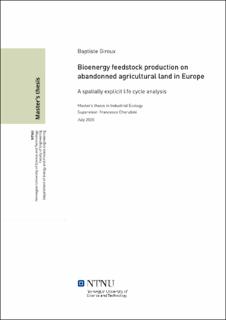Bioenergy feedstock production on abandonned agricultural land in Europe - A spatially explicit life cycle analysis
Master thesis
Permanent lenke
https://hdl.handle.net/11250/2779662Utgivelsesdato
2020Metadata
Vis full innførselSamlinger
Sammendrag
Forlatte jordbruksareal har vist seg som de mest lovende områdene for produksjon av bioenergisom vil minimere konkurranse med arealbruk med mat og tilhørende negative sosiale ogmiljømessige konsekvenser. Her undersøker vi den romlige variasjonen i miljøytelsen frastorskala produksjonen av bioenergi råstoff fra tre lovende flerårige avlinger dyrket på forlattavlingsland i Europa. Ulike vannforsyning og høstingstidspunkt er konsisert og sammenlignetfor å identifisere praksis som kan minimere miljøbelastningen. Til slutt utforsker dette arbeidetpotensialet og variasjonen i karbonbinding i jord fra biomasseproduksjon. Ved å bruke LCAmetodikkenog romlig eksplisitte estimater for avkastning og vannkrav fra GAEZ, beregneslivssykluspåvirkningene for forlatt avlingsland i Europa med en romlig oppløsning på 5buminutter. Resultatene viser at switchgrass generelt har det størstebiomasseproduksjonspotensialet i Europa sammen med den laveste miljøpåvirkningen perprodusert tonn. Irrigasjon øker potensialet for biomasse med 131% i gjennomsnitt til en kostnadav 300% økning i klimaendringseffekten. Forsinkelse av høsting på den annen side forbedrermiljøytelsen per tonn produsert tørrstoff. Dette arbeidet identifiserte områder i Sentraleuropasom omgir fjell og områder nordøst i Europa for å vise den beste biomasseproduksjonseffektiviteten (laveste påvirkning per produsert tonn). Områder i Nord-Øst-Europafaller også sammen med et høyt karbon-sekvestreringspotensial. Resultatene som er rapporterther, støtter funnene om at vanning generelt bør unngås for bioenergiproduksjon [1 23] og atforsinket høsting forbedrer miljøprestasjonen til en pris av stor nedgang i utbyttet (29% igjennomsnitt). Fremtidig forskning bør konsentrere seg om å utvikle mer pålitelige estimaterav jordiske organiske karbonforandringer under flerårige avlinger, slik at de systematisk kaninkluderes i livssyklusanalyse. Bedre redegjørelse for den romlige variasjonen inæringsstoffbehov, spesielt nitrogen virker også avgjørende for å identifisere områder med stortpotensial og lite miljøbelastning. Abandonned agricultural land have emerged as the most promising areas for the production ofbioenergy that would minimize land use competition with food and associated negative socialand environmental impacts. Here, we investigate the spatial variability of the environmentalperformance from the large scale production of bioenergy feedstock from three promisingperennial crops grown on abandonned cropland in Europe. Different water supply and harvesttiming are consisered and compared to identify practices that could minimize the environmentalimpact. Finally, this work explores the potential and variability of soil carbon sequestrationfrom biomass production. Using the LCA methodology and spatially explicit yield and waterrequirements estimates from GAEZ, life cycle impacts are computed for abandonned croplandin Europe at a spatial resolution of 5 arcminutes. Results show that switchgrass generally holdthe greatest biomass production potential for Europe alongside with the lowest environmentalimpact per ton produced. Irrigation increases biomass production potential by 131% on averageat the cost of a 300% increase in climate change impact. Delaying harvest in the other handimproves environmental performance per ton of dry matter produced. This work identified areasof central Europe surrounding mountains and areas in the north-east of Europe to show the bestbiomass production efficiency (lowest impact per ton produced). Areas of north-east Europealso coincide with high soil carbon sequestration potential. Results reported here support thefindings that irrigation should generally be avoided for bioenergy production [1] and thatdelayed harvest improves environmental performance at the cost of large decrease in yield (29%on average). Future research should concentrate on developing more reliable estimates of soilorganic carbon changes under perennial crops so that they can systematically be included in lifecycle analysis. Better accounting for the spatial variability of nutrient requirements, especiallynitrogen also appears crucial in identifying areas with high potential and low environmentalimpacts.
